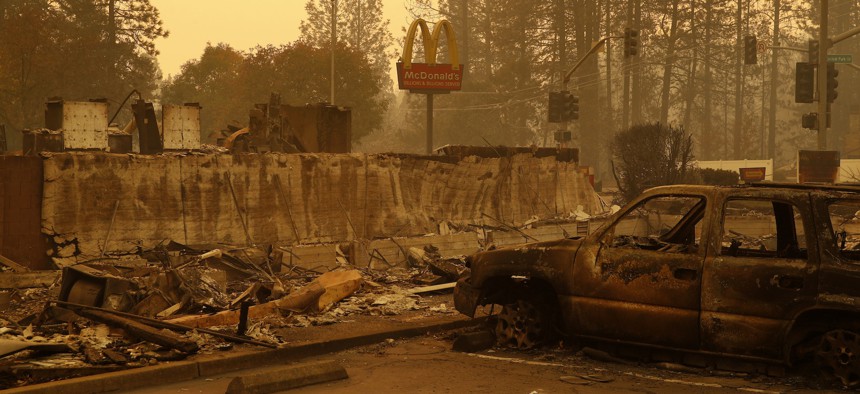California Utilities Feel Heat as State Burns

A sign still stands at a McDonald's restaurant burned in the Camp Fire, Monday, Nov. 12, 2018, in the northern California town of Paradise. John Locher / AP Photo

Connecting state and local government leaders
Fire investigators continue to look at the possible role power equipment may have played in starting the state’s deadliest wildfire on record.
Across California, people are looking at local power infrastructure with more concern this destructive fire season as investigators are probing the possible role faulty equipment may have played in starting the state’s deadliest blaze, which has killed at least 48 people, burned more than 125,000 acres and destroyed more than 7,100 structures in and around the town of Paradise, north of Sacramento. Many people remain unaccounted for and officials fear the death toll will rise.
As the widespread destruction continues with the Camp Fire in Northern California, firefighters continue to work to bring the Woolsey Fire in Los Angeles and Ventura counties under control. That blaze, which has burned through 150 square miles of land is now among the largest ever on record in Los Angeles County, according to the Los Angeles Times.
As Santa Ana winds threatened to create hazardous conditions for the wildfires in San Diego County this week, San Diego Gas & Electric Co. cut power to 30,000 customers on Tuesday morning as a safety precaution, mainly in the Escondido and Rancho Bernardo areas, The San Diego Union Tribune reported.
Stocks of PG&E Corp. and Edison International, two of the state’s big power utilities, have plunged since the Camp Fire in Northern California and the Woolsey Fire in Southern California, as Bloomberg reported, with investors “concerned about utility liabilities associated with the fires.”
The California Department of Forestry and Fire Protection has been investigating power equipment as a possible source of the Camp Fire in Butte County, north of Sacramento. The San Francisco Chronicle and other news outlets have reported on a woman who owns land near where the Camp Fire started who said that PG&E contacted her last week saying that it needed to do work on power equipment on or near her property, “raising further questions about the utility’s role in what has become California’s most destructive wildfire.”
Spokespeople for both companies have said they are cooperating with the investigations.
In addition to Cal Fire, the California Public Utilities Commission has launched its own investigation into the Camp Fire to “assess the compliance of electric facilities with applicable rules and regulations in fire impacted areas,” CPUC spokeswoman Terrie Prosper said Monday, according to the Chico Record-Enterprise. “The CPUC staff investigations may include an inspection of the fire sites once Cal Fire allows access, as well as maintenance of facilities, vegetation management, and emergency preparedness and response.”
PREVIOUSLY on Route Fifty:
Editor's Note: This article has been revised to update the death toll from the Camp Fire and fix an instance where the Camp Fire was misidentified as another Northern California wildfire, the Carr Fire.
Michael Grass is Executive Editor of Route Fifty and is based in Seattle.

NEXT STORY: Our National Infrastructure Problem Is Also a Mindset Problem





